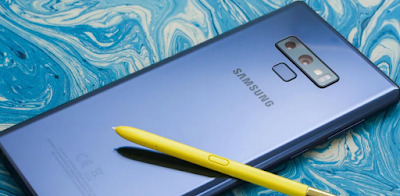Note 9 'losses': What Samsung's holding back for the Galaxy S10
Now that
Unpacked is over, what didn't we get from the Note 9? And what could Samsung be
saving for its next flagship?
At a New
York press event on Thursday, Samsung unveiled its new Galaxy Home smart home
speaker, a Galaxy Watch wearable and the high-end Note 9 phone. Featuring
incremental updates like a Bluetooth-enabled S Pen stylus, a higher-capacity
battery and a slightly bigger display, the Note 9 doesn't exactly deliver any
new earth-shattering technology in the mobile space.
That being
said, Samsung could be saving a lot of goodies for its next flagship phones in
2019 (yes, we're thinking that far ahead), which are expected to be called the
Galaxy S10 and S10 Plus.
In addition to the predictable advancements we expect to see in the next year (like running the latest Android 9.0 Pie OS out of the box, having the next Snapdragon processor from Qualcomm and improved camera features in general), we've compiled a list of features that we didn't get in the Note 9 -- features that we hope Samsung may just be holding off for its next Galaxy S10 go-round.
In-screen fingerprint reader
The Note 9's fingerprint reader is now located below the rear cameras. This is a notable improvement from the Note 8, which had the sensor right next to the camera lenses. While greasy fingerprints are less likely to smudge the camera with this new placement, an even better location for the reader would be within or beneath the display.

Vivo's in-screen fingerprint reader.
Known as Fingerprint On Display, or FOD, we've already seen this technology in the Vivo X20 Plus UD and Vivo Nex. The Porsche Design Huawei Mate RS, announced in March, has it too. We expect the feature to roll out in plenty of more phones in the near future, with one report from IHS Markit predicting it will be available in 100 million phones by 2019.
With the Note 9's expansive 6.4-inch screen, the phone definitely had room for it. Unfortunately, this is a trend waiting in the wings, so we may just have to wait for FOD in the Galaxy S10.
5G readiness
Known as 5G, the next generation of high-speed cellular technology is soon approaching, with broad US availability expected sometime in 2019 to 2020. US carriers like Verizon and AT&T are already setting up 5G networks and devices, while China is leading the pack by building 350,000 new cell phone towers since 2015.
Many phone makers have already announced their commitment to making 5G phones by next year, including Samsung. And last week, Motorola showed off its first 5G phone, the Moto Z3, which connects to the network with an attached Moto Mod accessory.
Because the Note 9 doesn't have 5G connectivity, we expect the Galaxy S10 to be part of this early 5G wave of phones. Especially since Samsung is putting more than $22 billion toward the technology (along with AI, biopharmaceuticals and other endeavors).

With the help of a Moto Mod, the Moto Z3 can hit 5G speeds for Verizon users.
3D front-facing cameras
The Note 9 combines iris and facial scanning to unlock your homescreen, but that's not quite the same as a secondary, 3D-mapping front-facing camera. Employed by Apple's iPhone X, this particular setup uses an infrared camera, a depth sensor and a dot projector to map out 30,000 points on your face and create an artificial 3D scan.
Samsung, please fix this.
Scott Stein/CNET
It's a faster and more secure way to recognize your face (something many phones do, though not using the same method), which means Apple can use its system for digital payments and smoother animated emojis (compared with Samsung's freaky AR emojis anyway).
True, if Samsung were to implement this on the Galaxy S10, it would be copying Apple. But haven't we already resigned ourselves to the fact that every phone company copies every other company these days? Plus, Android maker Xiaomi already jumped on the infrared-mapping tech bandwagon with its Mi 8 Explorer Edition. It's only be a matter of time until Samsung joins in the fray too.
A remappable Bixby button
With the Note 9, Samsung still makes its digital voice and search assistant Bixbyextra-accessible by adding a physical quick-launch button on the edge. Unfortunately, just like the Galaxy S9 and the iterations before it, you can't remap this button to open anything else. All it does is launch Bixby and Bixby only.
With the handful of apps and guides available online (including CNET's own!) that teach users a workaround to reprogram the button, hopefully Samsung will get the hint soon that people want more options when it comes to this button. Especially since it's physically easy to hit accidentally, resulting in numerous unwanted Bixby launches throughout the day.<







No comments:
Post a Comment